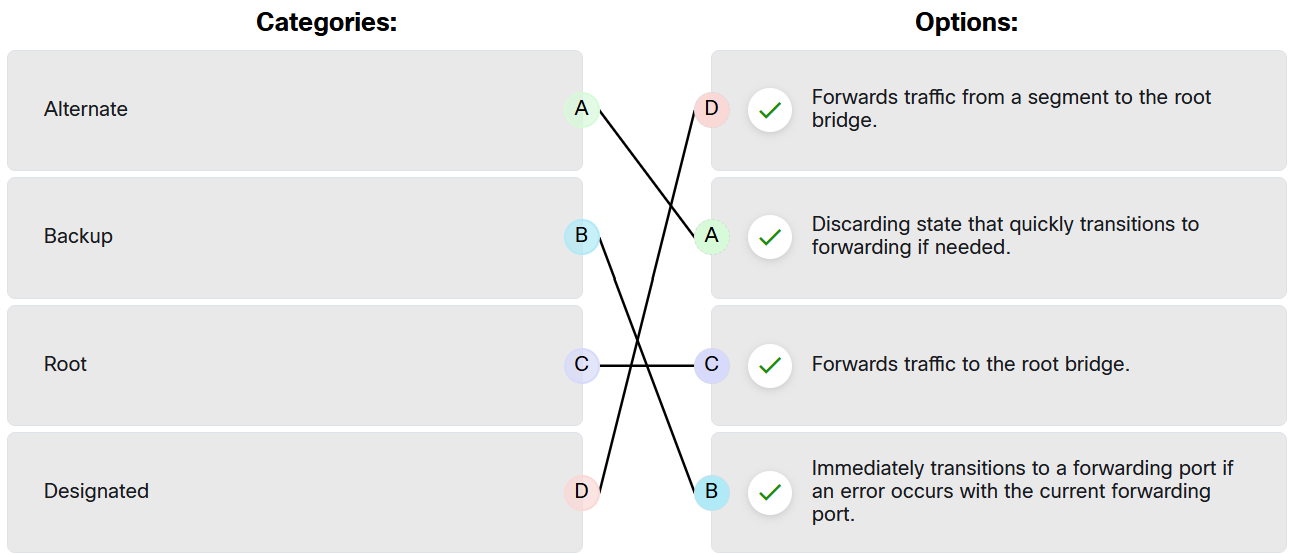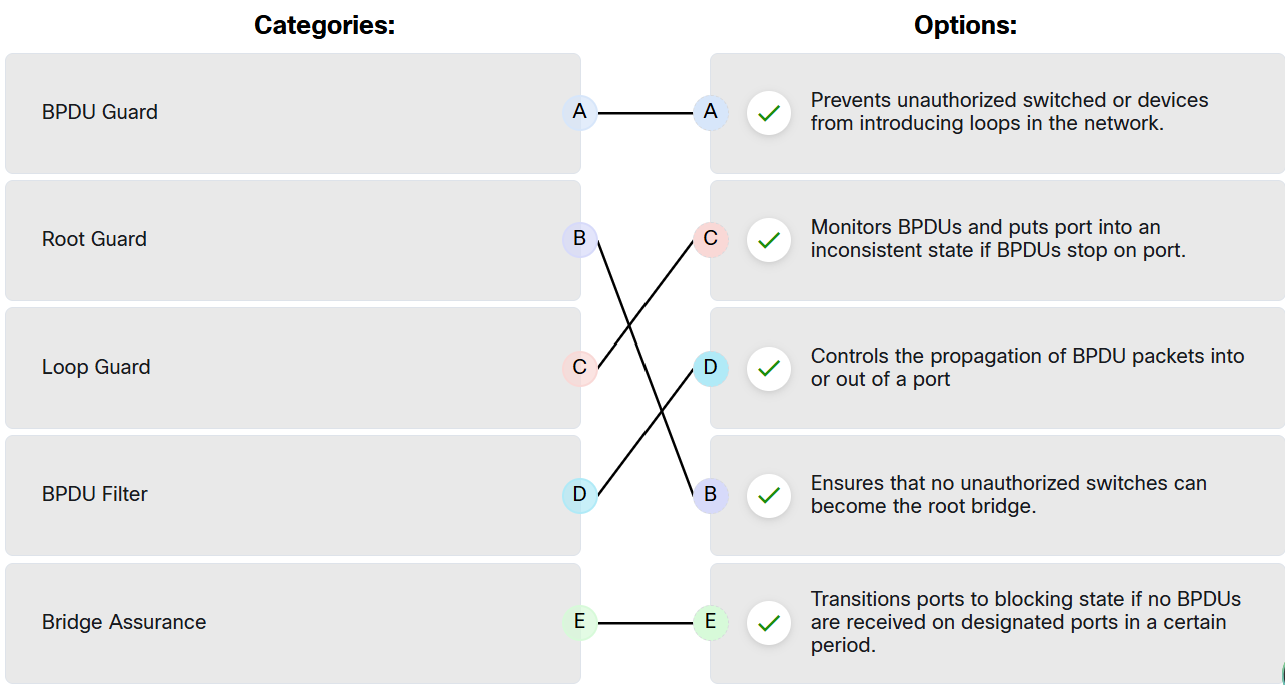1.3.2 Module Quiz Answers
Spanning Tree Protocol (STP) is a network protocol used to prevent loops in Ethernet networks. When redundant links are present in a network, loops can occur, causing broadcast storms and disrupting communication. STP operates at Layer 2 of the OSI model and ensures a loop-free topology by electing a root bridge and blocking redundant paths. It dynamically adjusts the network’s topology by using bridge protocol data units (BPDUs) to determine the shortest path to the root bridge while maintaining backup links in a standby state.
Rapid Spanning Tree Protocol (RSTP), introduced as IEEE 802.1w, is an enhancement of STP designed to improve convergence time in Ethernet networks. While STP can take 30 to 50 seconds to recalculate a network topology after a topology change, RSTP significantly reduces this time by introducing new port roles and states, such as Alternate and Backup ports, and by adopting a proactive approach to topology changes. This faster convergence makes RSTP suitable for modern, dynamic networks where rapid recovery is critical.
1. Match the port role to its description.

Place the options in the following order:
|
Designated
|
Forwards traffic from a segment to the root bridge.
|
|
Alternate
|
Discarding state that quickly transitions to forwarding if needed.
|
|
Backup
|
Immediately transitions to a forwarding port if an error occurs with the current forwarding port.
|
|
Root
|
Forwards traffic to the root bridge.
|
2. What is the main benefit of RSTP over STP?
- RSTP has more port states than STP.
- RSTP achieves faster convergence than STP.
- RSTP has less port roles than STP.
- BPDUs are only initiated by the root bridge in RSTP, whereas in STP all switches initiate BPDUs.
RSTP can achieve much faster convergence than STP in a properly configured network, sometimes in as little as a few hundred milliseconds. All switches in an RSTP network send BPDUs as a “keepalive” mechanism. RSTP has fewer port states but more port roles making it leaner and quicker to converge and reconverge after issues. RSTP minimizes downtime and ensures efficient data transmission.
3. A port on an RSTP switch is not forwarding frames, is blocked to prevent loops but is still able to listen to BPDUs to learn the network topology. What type of port state is being described?
- Learning
- Listening
- Discarding
- Disabled
In RSTP, a port that is in the discarding state is blocked to prevent loops, does not forward frames, and listens to BPDUs to learn the topology.
4. What does RSTP use to select the root bridge?
- The switch with the highest BID.
- The switch with the highest extended system ID.
- The switch with the lowest BID.
- The switch with the lowest MAC address.
RSTP selects the root bridge based on the lowest bridge ID. The bridge ID is a combination of the bridge priority (i.e., 32,768), the MAC address of the bridge and the VLAN ID.
5. In RSTP, a switch with four interfaces that connects to other RSTP switches, has been selected as the root bridge. What port type will be associated with the root bridge interfaces?
- all will be alternate ports
- all will be designated ports
- some will be root ports and some of them will be alternate ports
- all will be root ports
Since the switch is the root bridge, it does not need root ports. Therefore, all ports on a root bridge that are connected to other STP switches are designated ports.
6. A network administrator configures PortFast on access ports that are connected to end devices. What does the configuration accomplish?
- It prevents the forwarding of BPDUs to and from those access ports.
- The access ports are temporarily put into a loop-inconsistent state.
- The access ports will transition directly to the forwarding state.
- It ensures that an unauthorized switch cannot connect to those access ports.
The PortFast feature enables access ports connecting to end devices to transition directly to the forwarding state, thereby bypassing the listening and learning states.
7. Match the RSTP term with the description.

Place the options in the following order:
|
Loop Guard
|
Monitors BPDUs and puts port into an inconsistent state if BPDUs stop on port.
|
|
Bridge Assurance
|
Transitions ports to blocking state if no BPDUs are received on designated ports in a certain period.
|
|
BPDU Filter
|
Controls the propagation of BPDU packets into or out of a port.
|
|
Root Guard
|
Ensures that no unauthorized switches can become the root bridge.
|
|
BPDU Guard
|
Prevents unauthorized switched or devices from introducing loops in the network.
|
8. What happens if a BPDU is received on a port that has BPDU Guard configured?
- The BPDU is sent to the closest root port.
- The port is disabled.
- The BPDU is ignored.
- The BPDU is returned to the sender.
If a BPDU Guard-enabled port receives a BPDU, it triggers a security mechanism that puts the port into an error-disabled state and immediately disables (shuts down) the port.
9. Which two statements are correct concerning RSTP features? (Choose two.)
- PortFast should be configured on an interface that is configured as a trunk.
- BPDU Guard and BPDU Filter should not be configured on the same port.
- Loop Guard and Root Guard should be configured on the same port.
- PortFast and Root Guard must be configured on the same port.
- Only one RSTP feature should be configured on a port at the same time.
BPDU Guard and BPDU Filter: Do not configure a port with both commands since enabling both on the same interface effectively cancels the BPDU Guard feature.
Loop Guard and Root Guard should be configured together. While Root Guard protects against unauthorized switches attempting to become the root bridge, Loop Guard protects against unintended loops caused by link failures.
10. Where is the best place to configure BPDU filtering?
- on designated ports that connect to other switches
- on access ports that connect to end devices
- on all ports within the network
- on all root and trunking ports
BPDU Filter is best configured on access ports connecting to end devices to avoid unnecessary BPDU processing.
11. What is the function of a root port?
- It provides backup to a designated port.
- Every port on a root bridge is a route port.
- It forwards traffic to the root bridge.
- It connects to an end device.
The root port forwards traffic to the root bridge.
12. What RSTP solution prevents the connection of unauthorized switches to the network?
- BPDU Guard
- Loop Guard
- BPDU Filter
- Root Guard
Implement BPDU Guard on access ports to prevent the connection of unauthorized switches. Configuring Root Guard on the root bridge ports as well protects an unauthorized switch from becoming the root bridge selection.
13. A network technician enters the following global command: spanning-tree portfast bpduguard enable. What is accomplished with this command?
- It enables PortFast on all BPDU Guard enabled access ports.
- It does nothing since the command is only used in interface mode.
- It enables PortFast and BPDU Guard on all enabled access ports.
- It enables BPDU Guard on all Portfast enabled access ports.
The spanning-tree portfast bpduguard enable global config mode command enables BPDU Guard on all PortFast enabled access ports.
14. What occurs if a BPDU is received on a port enabled with BPDU Filter?
- The port is placed in an error-disabled state.
- The port is immediately disabled.
- The BPDU is ignored and the port remains functional.
- The port is placed into the loop-inconsistant state.
If a BPDU filter-enabled port receives a BPDU, it ignores it, and the port remains functional.
15. How are root ports selected?
- All ports on the root bridge become root ports.
- The port with the lowest BID on each non-root switch becomes the root port.
- The port with the lowest interface number on each non-root switch becomes the root port.
- The non-root switches find the port with the shortest path to the root bridge.